Family : Acanthuridae

Text © Giuseppe Mazza

English translation by Mario Beltramini
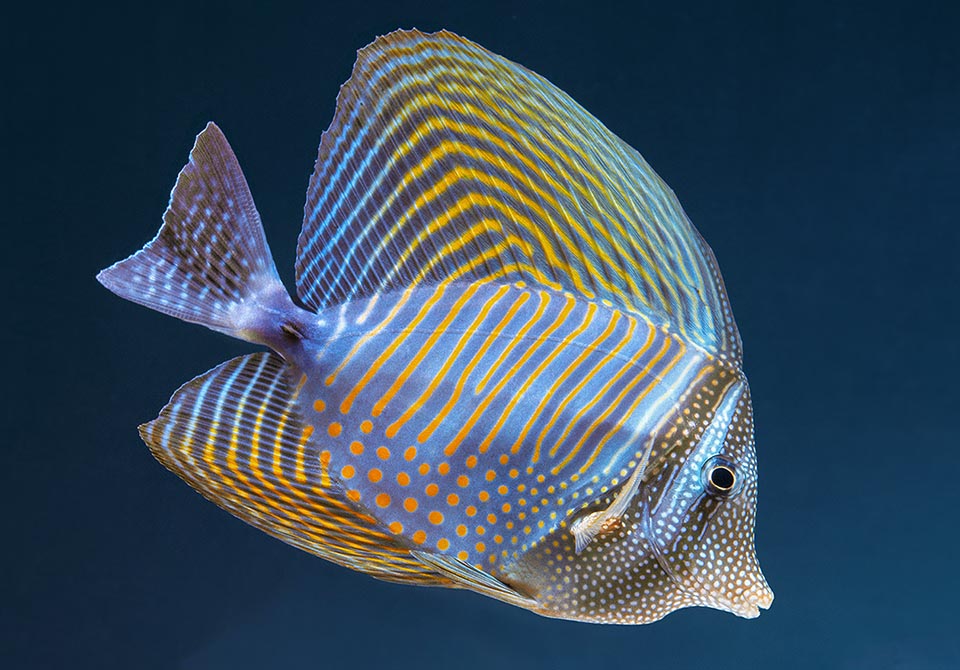
Imposing with spread fins to appear bigger to predators, the Indian sail-fin surgeonfish (Zebrasoma desjardinii) lives in the Red Sea and the Indian Ocean up to Indonesia © Giuseppe Mazza
The Indian sail-fin surgeonfish (Zebrasoma desjardinii Bennett, 1836) belongs to the class of Actinopterygii, the ray-finned fishes, to the order of Perciformes and to the famly of Acanthuridae.
The name of the genus Zebrasoma, comes from “zebra”, zebra in Latin, the well known African equine, and from the Greek “soma”, body, which means an animal “with striped body” due to bands unusually vertical in a surgeonfish.
The name of the species desjardinii honours the memory of the French zoologist Julien Desjardins (1799-1840) who has spent long time in the island of Mauritius and who was collaborating with the Paris Natural History Museum.
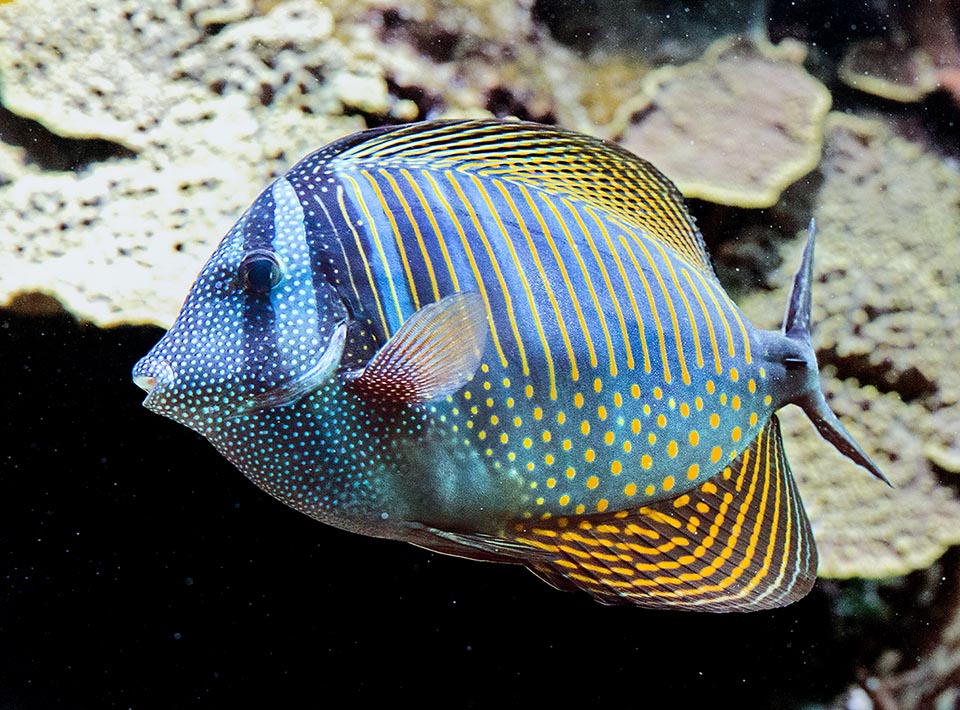
It’s a herbivore that may be 40 cm long and defends itself from intruders, like all razorfish, with his razor shaped blade located on the sides of the caudal peduncle © Giuseppe Mazza
Zoogeography
The Indian sail-fin surgeonfish is common in the Red Sea, in the Arabic Sea, in the Gulf of Aden and generally in the tropical waters of the Indian Ocean, from northern South Africa and Madagascar up to the Maldives, to India, Sri Lanka, Cocos Islands, Christmas Island and the western coasts of Indonesia.
Ecology-Habitat
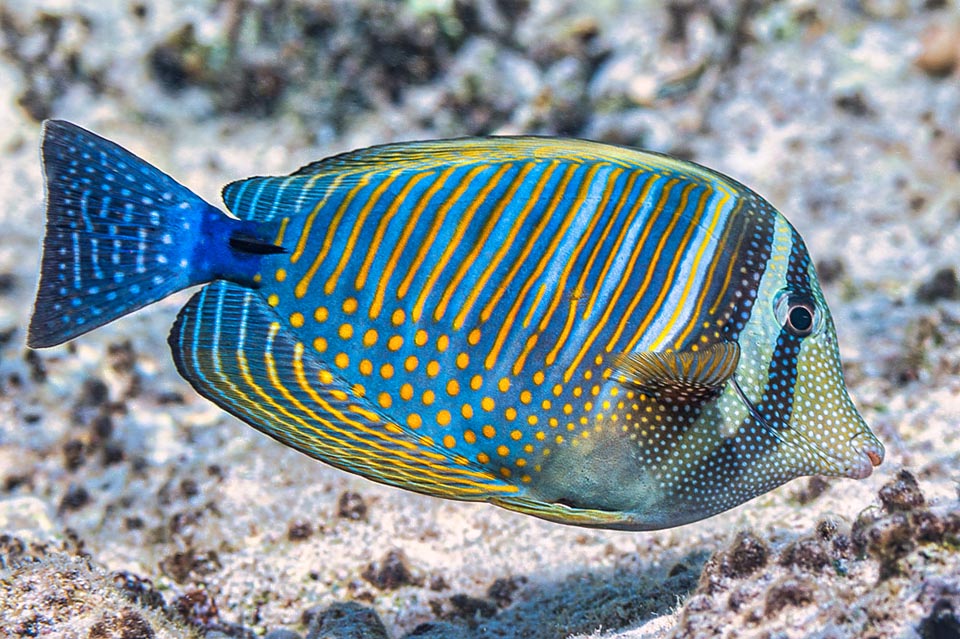
Protected by a fanciful camouflage livery, it can be found in madreporic formations and along rocky coasts rich in weeds, usually in the first 25 m of depth © François Libert
It lives in the madreporic formations and along the rocky coasts covered by seaweeds, usually in the first 25 metres of depth.
Morpho-physiology
It can reach the 40 cm, but the average size is of about 25 cm. The body is flat, impressing when the fins are spread as a sign of intimidation and becomes almost circular.
The dorsal, ¾ of the body high, has only 4 spiny rays and about 28 soft ones.
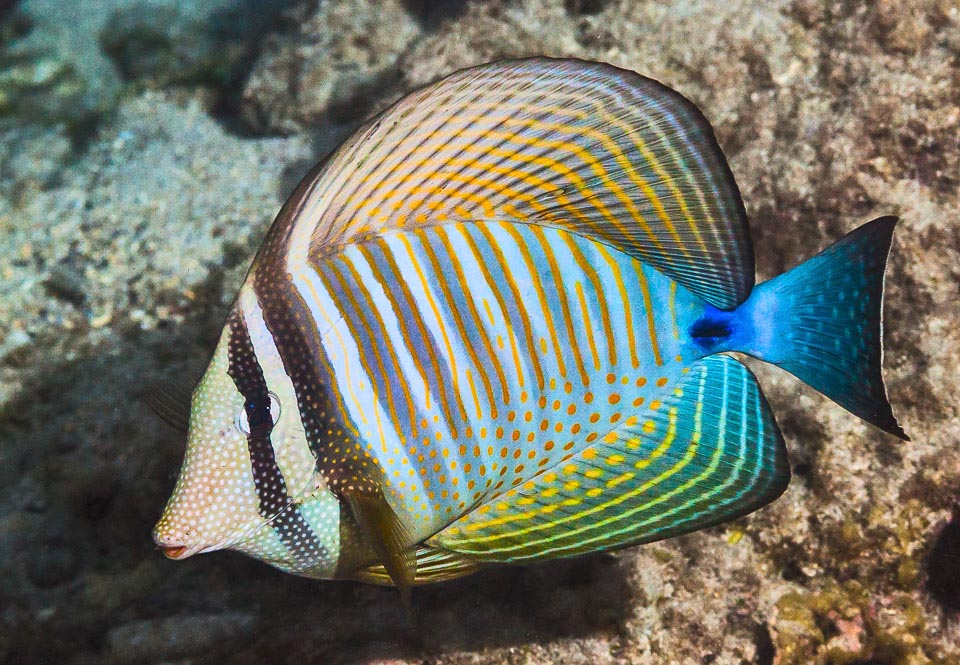
The colours are decidedly changeable, depending on the environment and the fish mood, with dark vertical bands. The first that masks the eye is the strongest and in the next, close to the pale dots, can be noticed the typical vertical yellow-orange stripes, more marked in the other bands, turn into dotting in the lower part of the body © François Libert
The anal is symmetrical, smaller, but in any case as wide as half of the body, counts 3 spines and about 23 unarmed rays.
The ventral fins, decidedly much modest in their size, have 1 spine and 5 soft rays; the pectoral ones are relatively long and pointed; the caudal is almost blunt.
The caudal peduncle shows the cutting blade typical of the surgeonfishes and the mouth has tiny teeth with 11 indentations above and 5 below.
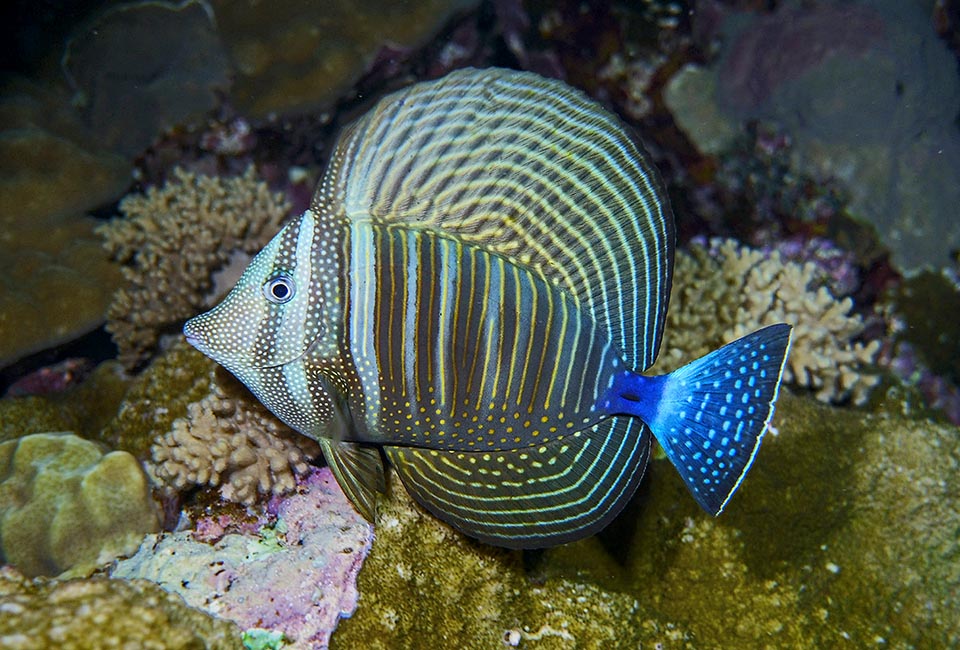
At the sunset the livery gets darker with shades tending to greenish while the light blue of the caudal fin turns on © Karine Marangon
The overall colour, more or less variable, is characterized by a brown, bluish or greenish background on which stands out a white dotting in the area of the head and a series of yellow-orange vertical stripes ending with spots aligned of the same colour, and are resumed, concentrically, by continuous parallel stripes on the dorsal and the anal.
There are two dark vertical bands in the zone of the head: one crosses the eye and the other stands at the level of the pectoral, with an evident mimetic function.
Ethology-Reproductive Biology
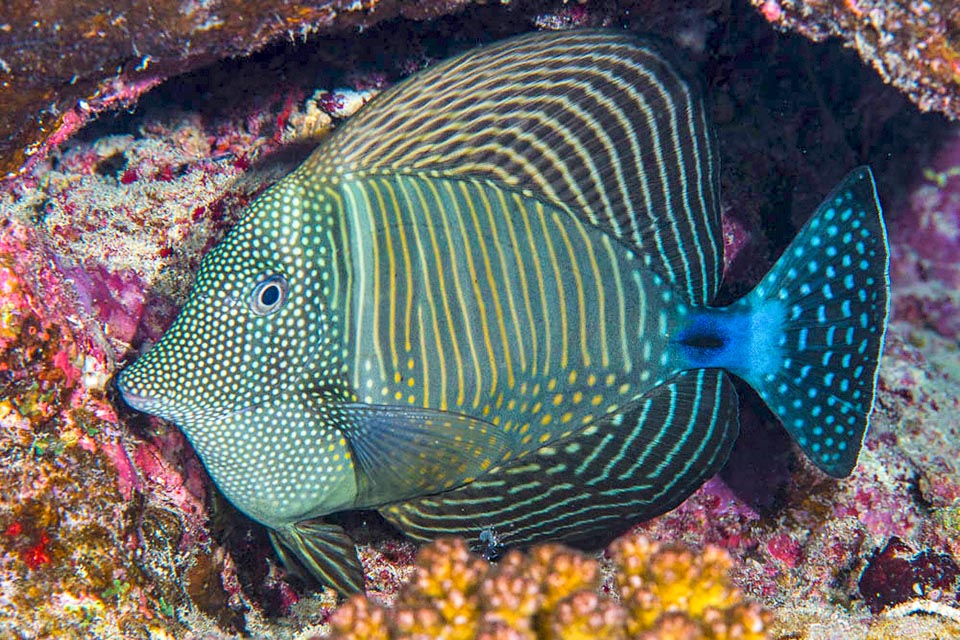
Finally, this is the night mimetic livery, where the contrast between the clear and dark vertical bands fades to disappear completely © François Libert
Zebrasoma desjardinii goes swimming mainly alone, grazing during the day benthic weeds, often fleshy, with a predilection for the green tufts of the genus Ulva.
Even if in the Red Sea have been noted chaotic gatherings for the reproduction, this usually happens in couples with pelagic eggs fecundated in the surface during the low tide after a characteristic courting swimming of the male.
This one, after making itself noticed by a female, goes up first of all in the overlying water column and waits for her. If reached. If it is reached, it swims around her in circles in a characteristic way, using only the pectorals, and touches her several times with its vibrating body.
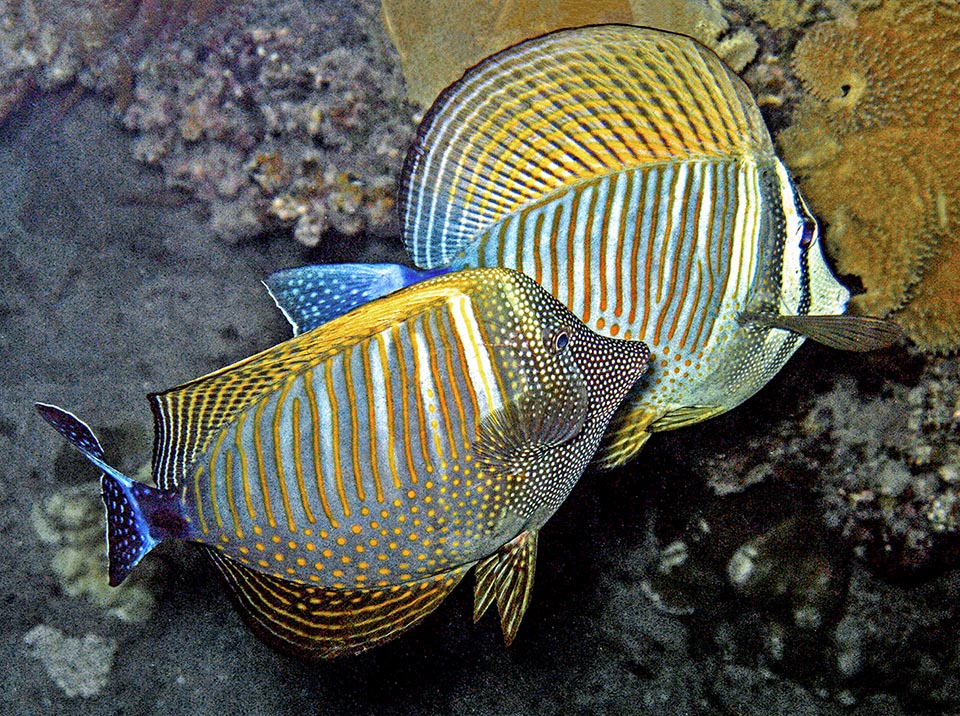
For reproduction the eggs are fecundated in surface during the low tide, and are not rare the disputes with rival males that sneak in the chosen zone © Gianemilio Rusconi
When this quickly rises to the surface this means that she is ready to lay and then it reaches her very quickly in order to fecundate the eggs that are entrusted to the currents.
Also the larvae are planktonic and the newborns move towards the seabeds when they reach the 2 cm. In the juvenile livery, quite different from the adult’s one, but similar to that of the young Zebrasoma velifer, the yellow prevails and the characteristic vertical black bands are already present.
The juveniles grow sheltered by the madrepores and it’s there that they are caught while sleeping for the aquarium fish market, even if later, seen their diet, they are not easy to nourish.
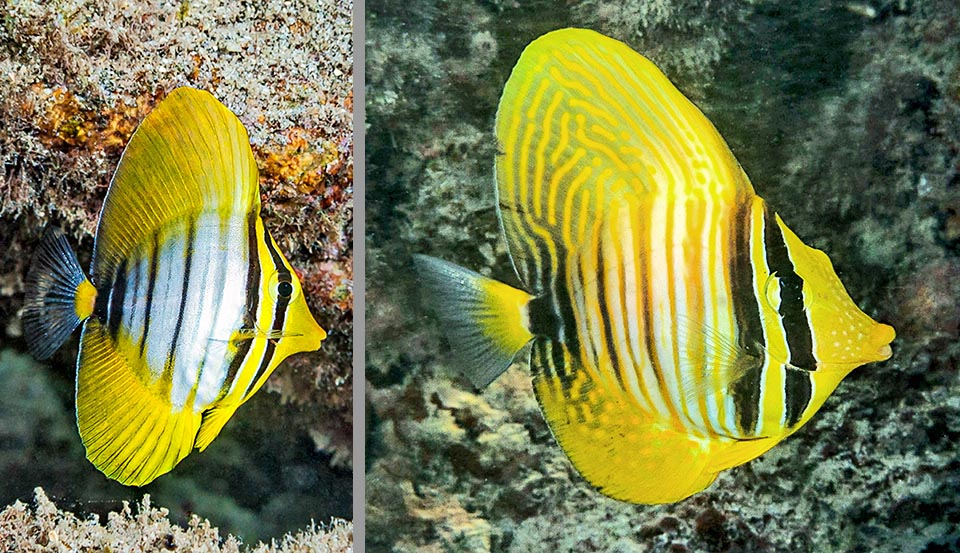
In the juvenile livery, very different, the yellow prevails. Here a male and a young subadult where the traits of the final livery begin to show up © François Libert
The flesh of the Indian sail-fin surgeonfish is definitely not valuable, but the adults that fall into the nets are locally consumed because it is not at risk of ciguatera, severe food poisoning.
The fishing vulnerability, moderate, marks 30 on a scale of 100 and the resilience is mediocre with a possible doubling of the populations in 1,4-4,4 years. Since 2010, Zebrasoma desjardinii is present in the Red List of the endangered species as “Least Concern“.
Synonyms
Acanthurus desjardinii Bennett, 1836.
→ For general information about FISH please click here.
→ For general information about BONY FISH please click here
→ For general information about CARTILAGINOUS FISH please click here.
→ To appreciate the BIODIVERSITY of BONY FISH please click here.
→ To appreciate the BIODIVERSITY of CARTILAGINOUS FISH please click here.
